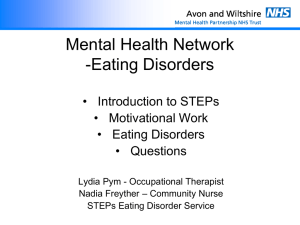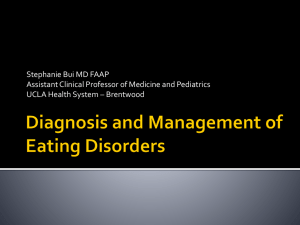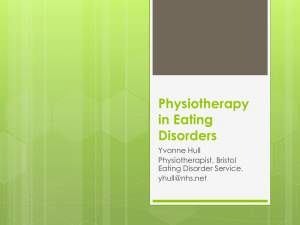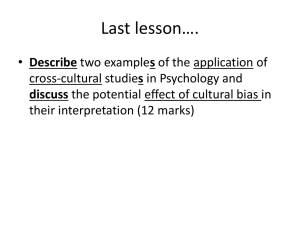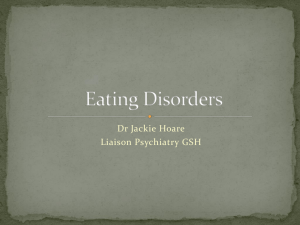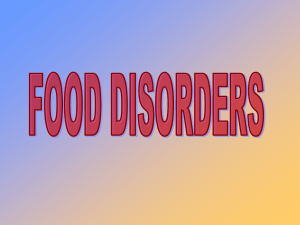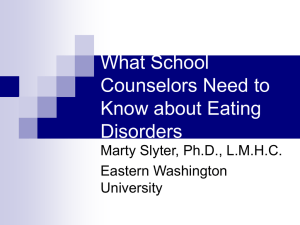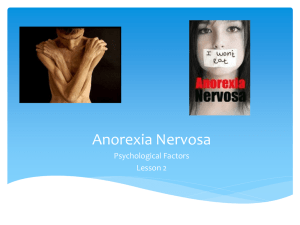Abnormal Psychology - - Eating Disorders
advertisement
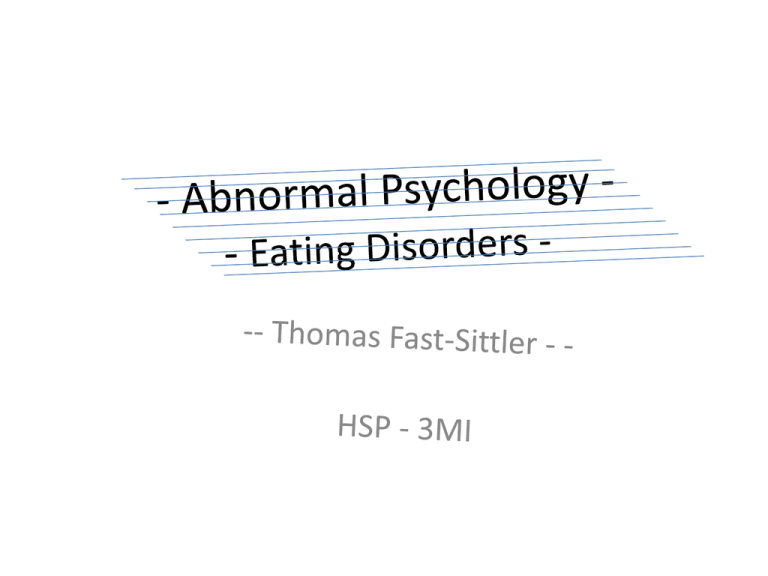
Before we begin • Key terms – Binge eating: To eat uncontrollably a (seemingly) large amount of food – Purge: To remove recently eaten food, either through vomiting or laxatives • To cleanse or remove – Nervosa Stats • According to a 2002 survey, 1.5% of Canadian women aged 15 – 24 years had an eating disorder • Female:Male = 8:1 • Children learn (unhealthy) mainstream attitudes towards food and weight at a very young age. In a study of five-yearold girls, a significant proportion of girls associated a diet with food restriction, weight-loss and thinness. • Thirty-seven percent of girls in grade nine and 40% in grade ten perceived themselves as too fat. Even among students of normal-weight (based on BMI), 19% believed that they were too fat, and 12% of students reported attempting to lose weight. Definitions • General Eating Disorder: A problem with food in some way • Anorexia Nervosa: (Anorexia, or AN) • an eating disorder where a person does not have a healthy body weight because they are scared of becoming overweight. • They will refuse to eat enough and always see themselves as fat • Bulimia Nervosa: (BN) • out of control eating, followed by a desire to get rid of the calories eaten, and will purge or use laxatives to remove it. • Eating Disorder not otherwise specified (EDNOS) Other eating disorders • Purging Disorder – Frequent purging (no binging) • Binge eating disorder – Frequent binging escapades (no purging) • Diabulimia – Manipulation of Insulin to control weight • Rumination Syndrome – involves regurgitation of food and re-eating or discarding it Causes • General Eating Disorder: • Genetic predisposition • Environment • Society – Fashions and expectations for looks • Low self-Esteem – Feel bad about yourself – Feel guilty about eating • Eating Disorder not otherwise specified (EDNOS) What causes Anorexia? • Usually caused by a diet or starvation: too little food. • Genetic predisposition is thought to run in families • Dysfunctional Family • Traumatic Experiences, such as rape * • People with Anorexia are often overachievers and focus on pleasing people, and view themselves more harshly. • Control Brad I felt very empowered by being able to do it. I felt like my personal hero for being able to control my body in that way and deny myself food and the enjoyment of eating. Development of Bulimia Nervosa • • • • • Culture – what society thinks is “beautiful” Hereditary – genetic predisposition Stress – from life and can trigger it * Personality – low self-worth Changes in hormones Marya The first time I ever threw up, I had been hating my body, hating my body and hating my body-for years... I stopped watching TV, put down my bag of Fritos and just sort of, in this drugged stupor, walked downstairs and pulled back my braids and threw up. Psychologist’s theories • Freud considered eating disorders to be some form of oral fixation, but didn’t elaborate on it very much • Maslow thought that eating disorders occurred in people who had low self-esteem (level 4) Anorexia • Anorexia: – Anorexia can cause menstruation to stop, it often leads to bone loss, and loss of skin health. The disorder stresses the heart and increases the risk of death • This is caused by malnutrition • AN has the highest mortality rate of any psychiatric illness – it is estimated that 10% of individuals with AN will die within 10 years of the onset of the disorder. AN – symptoms continued . • Russell’s signs – from purging http://en.wikipedia.org/wiki/File:Russell%27s_Sign.png Heart rate problems Slow heart rate (bradicardia) Symptoms • Bulimia Nervosa: – Out of control eating – Purging follows – People are afraid they will gain weight and this leads to – Holding off on food – Then the need to gorge because of the great hunger – Now all the calories taken in lead to the need to get rid of them by purging. – Eating becomes very irregular and it feels out of control for the person Bulimia Symptoms • • • • • Abdominal pain Fatigue Energy Loss Loss of menstrual cycle in women Plus health problems like: – Teeth decay and gum disease, voice damage, face swelling – Dehydration, muscle loss, brittle skin, hair loss, ↑ BP, anemia - malnutrition – Old – Bulimia also causes great health problems, which include dehydration, hyponatremia, laxative dependence, Anorexia • Treatment involves: – A person has to want to do it – Getting the anorexic to a healthy weight through proper eating that meets dietary needs – Treating the psychological issues related to eating – Getting rid of the behaviors that could cause the person to become anorexic again. – A stay in a hospital can take upwards of a month for full treatment Treatments • Treatments for bulimia involve: – Counseling and support – Anti-depressant and anti-psychotic drugs * – Usually must be in rehab for at least a month – This could be expensive in the U.S. Virginia Part of the journey of getting better for the child or the spouse, or whomever has the eating disorder... that person is going to have to find herself or himself. And that's the journey to recovery. Prevention • It is important to support people who might have a tendency to develop an eating disorder. • People who are at risk of developing eating disorders need encouragement and positive reinforcement from family and friends • If there is less pressure to look a certain way, then I believe that people would feel less pressured to look a certain way Conclusion • Both bulimia and anorexia are the misuse of food to resolve emotional problems. • Bulimia Nervosa, just like Anorexia Nervosa, takes people’s lives. We need to be very observing of our family members and our friends, especially because these conditions are easy to hide and patients never admit to anything. Sources • • • • • • • • • • • • • • • • http://en.wikipedia.org/wiki/Eating_disorder http://www.eatingdisordershelpguide.com/types.html http://www.nationaleatingdisorders.org/nedaDir/files/documents/handouts/WhatCaus.pdf This is something I haven’t used yet, http://www.pbs.org/perfectillusions/index.html - personal stories http://www.state.sc.us/dmh/anorexia/statistics.htm - US stats http://www.umm.edu/patiented/articles/how_serious_anorexia_nervosa_000049_5.htm - QRS http://findarticles.com/p/articles/mi_m0887/is_8_19/ai_64714672/ - study http://www.nedic.ca/knowthefacts/statistics.shtml - Canadian stats and thoughts http://www.medscape.com/viewarticle/711212 http://en.wikipedia.org/wiki/Anorexia_nervosa -self explanatory http://helpguide.org/mental/anorexia_signs_symptoms_causes_treatment.htm *** http://jubave.com/2007/08/15/what-is-bulimia/ http://www.indianwomenshealth.com/Eating-Disorders-166.aspx http://www.zimbio.com/pictures/Jvx1LwENJop/2009+Milan+Fashion+Week+Etro+Fashion+Show/V Mo845UIO_L/Magdalena+Frackowiak http://www.umm.edu/patiented/articles/what_causes_eating_disorders_000049_3.htm
